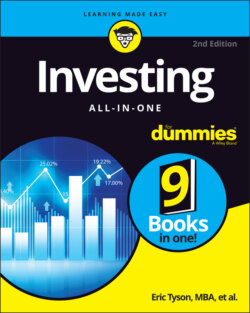Читать книгу Investing All-in-One For Dummies - Eric Tyson - Страница 85
Determining the cost basis of your shares
ОглавлениеWhen you sell a portion of the shares of a security (such as a stock, bond, or mutual fund) that you own, specifying which shares you’re selling may benefit you taxwise. Here’s an example to show you why you may want to specify selling certain shares — especially those shares that cost you more to buy — so you can save on your taxes.
Suppose you own 300 shares of a stock, and you want to sell 100 shares. You bought 100 of these shares a long, long time ago at $10 per share, 100 shares two years ago at $16 per share, and the last 100 shares one year ago at $14 per share. Today, the stock is at $20 per share. Although you didn’t get rich, you’re grateful that you haven’t lost your shirt the way some of your stock-picking pals have.
The Internal Revenue Service allows you to choose which shares you want to sell. Electing to sell the 100 shares that you purchased at the highest price — those you bought for $16 per share two years ago — saves you in taxes now. To comply with the tax laws, you must identify the shares that you want the broker to sell by the original date of purchase and/or the cost when you sell the shares. The brokerage firm through which you sell the stock should include this information on the confirmation that you receive for the sale.
The other method of accounting for which shares are sold is the method that the IRS forces you to use if you don’t specify before the sale which shares you want to sell — the first-in-first-out (FIFO) method. FIFO means that the first shares that you sell are simply the first shares that you bought. Not surprisingly, because most stocks appreciate over time, the FIFO method usually leads to your paying more tax sooner. The FIFO accounting procedure leads to the conclusion that the 100 shares you sell are the 100 that you bought long, long ago at $10 per share. Thus, you owe a larger amount of taxes than if you’d sold the higher-cost shares under the specification method.
Although you save taxes today if you specify selling the shares that you bought more recently at a higher price, when you finally sell the other shares, you’ll owe taxes on the larger profit. The longer you expect to hold these other shares, the greater the value you’ll likely derive from postponing, realizing the larger gains and paying more in taxes.
When you sell shares in a mutual fund, the IRS has yet another accounting method, known as the average cost method, for figuring your taxable profit or loss. This method comes in handy if you bought shares in chunks over time or reinvested the fund payouts in purchasing more shares of the fund. As the name suggests, the average cost method allows you to take an average cost for all the mutual fund shares you bought over time.
